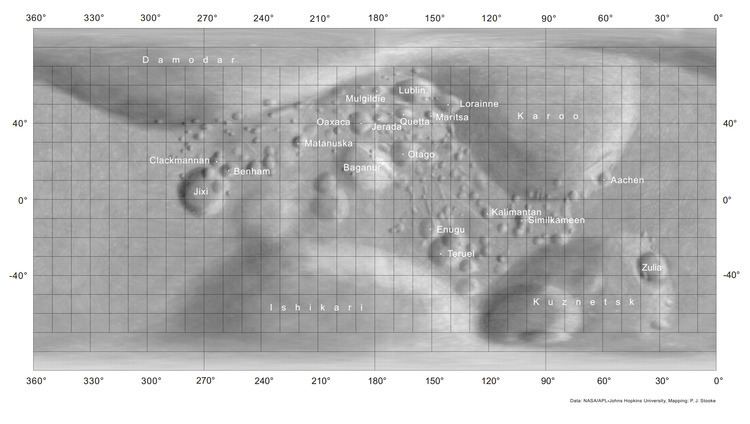Pronunciation /məˈtɪldə/ Alternative names 1949 OL1, A915 TN Discovered 12 November 1885 | Discovery date 12 November 1885 Named after Mathilde Loewy Minor planet category Main belt Discoverer Johann Palisa Asteroid group Asteroid belt | |
Similar Johann Palisa discoveries, Other celestial objects | ||
253 Mathilde /məˈtɪldə/ is a main-belt asteroid about 50 km in diameter that was discovered by Johann Palisa in 1885. It has a relatively elliptical orbit that requires more than four years to circle the Sun. This asteroid has an unusually slow rate of rotation, requiring 17.4 days to complete a 360° revolution about its axis. It is a primitive C-type asteroid, which means the surface has a high proportion of carbon; giving it a dark surface that reflects only 4% of the light that falls on it.
Contents
This asteroid was visited by the NEAR Shoemaker spacecraft during June 1997, on its way to asteroid 433 Eros. During the flyby, the spacecraft imaged a hemisphere of the asteroid, revealing many large craters that have gouged out depressions in the surface. It was the first C-type asteroid to be explored and, until 21 Lutetia was visited in 2010, it was the largest asteroid to be visited by a spacecraft.

Observation history

In 1880, Johann Palisa, the director of the Austrian Naval Observatory, was offered a position as an assistant at the newly completed Vienna Observatory. Although the job represented a demotion for Johann, it gave him access to the new 27-inch (690 mm) refractor, the largest telescope in the world at that time. By this point Johann had already discovered 27 asteroids, and he would employ the Vienna 27-inch (690 mm) and 12-inch (300 mm) instruments to find an additional 94 asteroids before he retired.
Among his discoveries was the asteroid 253 Mathilde, found on November 12, 1885. The initial orbital elements of the asteroid were then computed by V. A. Lebeuf, another Austrian astronomer working at the observatory. The name of the asteroid was suggested by Lebeuf, after Mathilde, the wife of Moritz Loewy—who was the vice director of the Paris Observatory.
In 1995, ground-based observations determined that 253 Mathilde is a C-type asteroid. It was also found to have an unusually long period of rotation.
On June 27, 1997, the NEAR Shoemaker spacecraft passed within 1,212 km of 253 Mathilde while moving at a velocity of 9.93 km/s. This close approach allowed the spacecraft to capture over 500 images of the surface, and provided data for more accurate determinations of the asteroid's dimensions and mass (based on gravitational perturbation of the spacecraft). However, only one hemisphere of 253 Mathilde was imaged during the fly-by. This was only the third asteroid to be imaged from a nearby distance, following 951 Gaspra and 243 Ida.
Description
253 Mathilde is very dark, with an albedo comparable to fresh asphalt, and is thought to share the same composition as CI1 or CM2 carbonaceous chondrite meteorites, with a surface dominated by phyllosilicate minerals. The asteroid has a number of extremely large craters, with the individual craters being named for coal fields and basins around the world. The two largest craters, Ishikari (29.3 km) and Karoo (33.4 km), are as wide as the asteroid's average radius. The impacts appear to have spalled large volumes off the asteroid, as suggested by the angular edges of the craters. No differences in brightness or colour were visible in the craters and there was no appearance of layering, so the asteroid's interior must be very homogeneous. There are indications of material movement along the downslope direction.
The density measured by NEAR Shoemaker, 1,300 kg/m³, is less than half that of a typical carbonaceous chondrite; this may indicate that the asteroid is very loosely packed rubble pile. The same is true of several C-type asteroids studied by ground-based telescopes equipped with adaptive optics systems (45 Eugenia, 90 Antiope, 87 Sylvia and 121 Hermione). Up to 50% of the interior volume of 253 Mathilde consists of open space. However, the existence of a 20-km-long scarp may indicate that the asteroid does have some structural strength, so it could contain some large internal components. The low interior density is an inefficient transmitter of impact shock through the asteroid, which also helps to preserve the surface features to a high degree.
Mathilde's orbit is eccentric, taking it to the outer reaches of the main belt. Nonetheless, the orbit lies entirely between the orbits of Mars and Jupiter; it does not cross the planetary orbits. It also has one of the slowest rotation periods of the known asteroids—most asteroids have a rotation period in the range of 2–24 hours. Because of the slow rotation rate, NEAR Shoemaker was only able to photograph 60% of the asteroid's surface. The slow rate of rotation may be accounted for by a satellite orbiting the asteroid, but a search of the NEAR images revealed none larger than 10 km in diameter out to 20 times the radius of 253 Mathilde.
